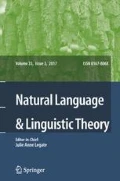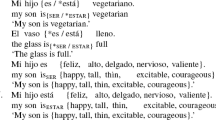Abstract
Gumiel-Molina et al. (this issue) propose that a typology of comparison classes, which has been argued to figure in the analysis of the relative/absolute distinction, has a crucial role in explaining the distribution of adjectives with Spanish copulas ser/estar. This commentary briefly summarizes the main claims and notes several advantages of the proposed analysis. Two further questions arise as a consequence of the approach developed, which are discussed in subsequent sections. One concerns the status of scale structure, and whether it is a lexically-listed property or whether it is also syntactically built up and encoded in functional categories. Some evidence supporting the latter is discussed. Second, the question arises as to whether the unexpected invariance of certain adjectives can be explained in terms of the effects of additional functional categories. Some support for this is adduced for perfective adjectives, which are proposed to differ from other adjectives in terms of their structure, which includes VP structure and VP-related functional category of Aspect.
Similar content being viewed by others
Notes
The relevant PP is analyzed by Gallego and Uriagereka (2009, 2011) as a predicate of terminal coincidence; Zagona (2012) it is a PP of Location, which can have either spatial value, as in (6) in the text or temporal value as a PP or temporal location (Aspect Phrase). There is a long-standing controversy in the literature as to whether the ser/estar alternation involves an individual/stage distinction or an aspectual distinction (Luján 1981; Roby 2009, among others; for discussion of the alternatives see Fernández Leborans 1999). The hypothesis that the relative/absolute distinction is syntactically built up suggests that both distinctions are relevant for adjectives, one being relevant for the analysis of the adjective’s Degree Phrase, the other for the copular VP in which it is embedded. For some discussion see Zagona (2014).
The symbol ‘*’ indicates a contradiction, following the convention adopted by G-M et al.
For G-M et al. (personal communication), (9) is not necessarily contradictory, but is acceptable in a context where Alicia is 8 years old and is 1.25 meters tall (and is therefore short for her age), while Juan is 5 years old and is 1.20 meters tall (and is therefore tall for his age). (See also their note 11.) They point out, however, that for reasons that remain unclear, the sentence is only grammatical if para su edad ‘for his/her age’ is added. (Example due to G-M et al.)
-
(i)

One possible explanation for the difference in status between (9) and (i) is that the adjuncts in (i) alter the scale itself, not just the scale structure. The first conjunct appears to refer to a scale of tallness-for-one’s-age, a distinct property from absolute tallness. That is, the scale in the first conjunct identifies the amount of tallness acquired per unit of time, similar to (9) in the text.
-
(i)
Some adjectives like seco ‘dry/dried’ are ambiguous between perfective properties and a simple stative interpretation; only the imperfective variant is compatible with ser.
Perfective adjectives exhibit invariant absolute behavior even if there is no synchronic verb from which they can be derived (Fábregas 2012). It may be that the lexical entries for these adjectives encode the functional feature values for the participles from which they were originally derived.
Unergative participles like caminado, ‘walked’, volado ‘flew’ are only possible as verbal participles.
A parallel case of modifiers that are excluded due to locality constraints is (i):
-
(i)
John has arrived (*)yesterday.
In (i), yesterday cannot modify Ev-T because no licensing relation can be established between EvT and Speech time, given the presence of the intervening Assertion time. The adverb cannot modify Assertion time because Assertion time is a present interval, whereas yesterday must modify a past interval. Similar considerations prevent ayer from modifying the Assertion time in (18) in the text.
-
(i)
References
Bosque, Ignacio. 1990. Sobre el aspecto en los participios y los adjetivos. In Tiempo y aspecto en Español, ed. Ignacio Bosque, 177–210. Madrid: Cátedra.
Bosque, Ignacio. 1999. El sintagma adjetival. In Gramática descriptiva de la lengua española, eds. Ignacio Bosque and Violeta Demonte, 217–310.
Demirdache, Hamida, and Miriam Uribe-Etxebarria. 2000. The primitives of temporal relations. In Step by step: essays on minimalist syntax in honor of Howard Lasnik, eds. Roger Martin, David Michaels, and Juan Uriagereka, 157–186. Cambridge: The MIT Press.
den Dikken, Marcel. 2006. Relators and linkers: the syntax of predication, predication inversion, and copulas. Cambridge: MIT Press.
Fábregas, Antonio. 2012. A guide to IL and SL in Spanish: properties, problems and proposals. Borealis: An International Journal of Hispanic Linguistics 1–2: 1–71. doi:10.7557/1.1.2.2296.
Fernández Leborans, María Jesús. 1999. La predicación: las oraciones copulativas. In Gramática descriptiva de la lengua española, eds. Ignacio Bosque and Violeta Demonte, 2357–2460.
Gallego, Ángel, and Juan Uriagereka. 2009. Estar=Ser+P. Paper given at the 19th Colloquium on Generative Grammar (CGG), April 2, 2009, Vitoria-Gasteiz, University of the Basque Country.
Gallego, Ángel, and Juan Uriagereka. 2011. The lexical syntax of ser and estar. Unpublished manuscript. Barcelona: Universitat Autònoma de Barcelona and College Park, MD: University of Maryland.
Gehrke, Berit. this issue. Adjectival participles, event kind modification and pseudo-incorporation. Natural Language and Linguistic Theory.
Gumiel-Molina, Silvia, Norberto Moreno-Quibén, and Isabel Pérez-Jiménez. this issue. Comparison classes and the relative/absolute distinction: a degree-based compositional account of the ser/estar alternation in Spanish. Natural Language and Linguistic Theory.
Gumiel-Molina, Silvia, and Isabel Pérez-Jiménez. 2012. Aspectual composition in “ser/estar + adjective” structures: adjectival scalarity and verbal aspect in copular constructions. Borealis: An International Journal of Hispanic Linguistics 1: 33–62. http://septentrio.uit.no/index.php/borealis/article/view/2321.
Heycock, Caroline. 2013. The syntax of predication. In The Cambridge handbook of generative syntax, ed. Marcel den Dikken, 322–352. Cambridge: CUP.
Kennedy, Christopher. 2007. Vagueness and grammar: the semantics of relative and absolute gradable adjectives. Linguistics and Philosophy 30(1): 1–45.
Kennedy, Christopher, and Louise McNally. 2005. Scale structure, degree modification, and the semantics of gradable predicates. Language 81: 345–381.
Luján, Marta. 1981. Spanish copulas as aspect indicators. Lingua 54: 165–210.
Roby, David. 2009. Aspect and the categorization of states: the case of ser and estar. In Spanish, Amsterdam: John Benjamins.
Toledo, Assaf, and Galit Sassoon. 2011. Absolute vs. relative adjectives—variance within vs. between individuals. Semantics and Linguistics Theory (SALT) 21: 135–154.
Zagona, Karen. 2012. Ser and estar: phrase structure and aspect. In Building a bridge between linguistic communities of the Old and the New World: Cahiers Chronos 8, eds. Chiyo Nishida and Cinzia Russi. Amsterdam: Rodopi.
Zagona, Karen. 2014. Three functional categories that determine adjectival temporal structure: Anatomy of the ser/estar alternation. Paper presented at the 24th Coloquio de Gramática Generativa. Madrid.
Zagona, Karen. To appear. Location and the ser/estar alternation. In eds. Manuel Leonetti, Silvia Gumiel, and Isabel Pérez. Ser & estar at the interfaces. Amsterdam: John Benjamins.
Zagona, Karen, and Heles Contreras. 2011. Sobre la incompatibilidad entre ser y los adjetivos con complemento: un análisis sintáctico. In 60 problemas de gramática: homenaje a Ignacio Bosque, eds. Victoria Escandell Vidal, Manuel Leonetti, and Cristina Sánchez López, 100–105. Madrid: Editorial Akal.
Acknowledgements
I am very grateful to Silvia Gumiel-Molina, Norberto Moreno-Quibén, Isabel Pérez-Jiménez, Berit Gehrke, Elena Castroviejo and an anonymous reviewer for comments on preliminary versions of this paper. I extend my thanks as well to Antxon Olarrea for commenting on some grammaticality contrasts, and to Heles Contreras for discussion of data and analysis. All remaining errors and omissions are my responsibility alone.
Author information
Authors and Affiliations
Corresponding author
Rights and permissions
About this article
Cite this article
Zagona, K. Comparison classes, the relative/absolute distinction and the Spanish ser/estar alternation: commentary on the paper by Gumiel-Molina, Moreno-Quibén and Pérez-Jiménez. Nat Lang Linguist Theory 33, 1003–1017 (2015). https://doi.org/10.1007/s11049-015-9283-y
Received:
Accepted:
Published:
Issue Date:
DOI: https://doi.org/10.1007/s11049-015-9283-y





